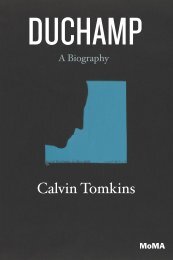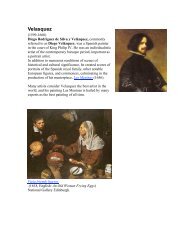Still Life in Watercolors
qbj8dgc
qbj8dgc
- No tags were found...
Create successful ePaper yourself
Turn your PDF publications into a flip-book with our unique Google optimized e-Paper software.
Carol Armstrong (Pr<strong>in</strong>ceton: Pr<strong>in</strong>ceton University<br />
Art Museum, 2002), 13-25, esp. 14; also <strong>in</strong> Gôtz<br />
Adriani, Cézanne <strong>Watercolors</strong>, trans. Russell M.<br />
Stockman (New York: Harry N. Abrams, 1983), 21.<br />
7. "Quand j'étais a Aix, il me semblait que je<br />
serais mieux autre part, ma<strong>in</strong>tenant que je suis ici,<br />
je regrette Aix" (Cézanne to Solari, Talloires, July 23,<br />
1896, cited <strong>in</strong> Denis Coutagne and Bruno Ely, Les<br />
Sites cézanniennes du pays d'Aix: Hommage à<br />
John Rewald [Paris: Réunion des Musées Nationaux,<br />
1996], 197).<br />
8. "Et n'eût été que j'aime énormément la configuration<br />
de mon pays, je ne serai pas ici." What<br />
he compla<strong>in</strong>ed of were "les prétensions des <strong>in</strong>tellectuels<br />
de mon pays, tas d'enculés, de crét<strong>in</strong>s<br />
et de drôles—les steppes de la bonne ville d'Aix"<br />
(ibid., 228).<br />
9. "En nous ne s'est pas endormie la vibration de<br />
sensations répercutées de ce bon soleil de Provence,<br />
nos vieux souvenirs de jeunesse, de ces horizons,<br />
de ces paysages, de ces lignes <strong>in</strong>ouïes, qui laissent<br />
en nous tant d'impressions profondes" (Cézanne<br />
to Henri Gasquet, June 1899, cited ibid., 198).<br />
10. Compla<strong>in</strong><strong>in</strong>g about the old Aix, Cézanne also<br />
bemoaned the efforts to modernize it, conclud<strong>in</strong>g,<br />
"J'y suis né; j'y mourrai. . . . Aujourd'hui tout change<br />
en réalité, mais non pour moi, je vis dans la ville<br />
de mon enfance, et c'est dans le regard des gens<br />
de mon âge que je revois le passé" (ibid., 228).<br />
11. Cézanne tried twice to get <strong>in</strong>to the Ecole des<br />
Beaux Arts <strong>in</strong> the early sixties, without success.<br />
After that, he submitted works to the Salon <strong>in</strong> 1863,<br />
1865, 1866, 1867, 1868, 1869, 1870, 1872, 1876,<br />
1879, l88o > l88l > l882 > and l88 4- He nad a still life<br />
<strong>in</strong> the Salon des Refusés of 1863 and a portrait<br />
accepted <strong>in</strong>to the Salon of 1882, but only because he<br />
got around the jury by list<strong>in</strong>g himself as a student<br />
of another pa<strong>in</strong>ter, a loophole that was resc<strong>in</strong>ded<br />
the follow<strong>in</strong>g year. Otherwise none of his Salon submissions<br />
was accepted. He did not participate <strong>in</strong> any<br />
of the Impressionist exhibitions after 1877 but did<br />
beg<strong>in</strong> exhibit<strong>in</strong>g with Les V<strong>in</strong>gt <strong>in</strong> Brussels <strong>in</strong> 1889.<br />
Thereafter he had other exhibition opportunities,<br />
he began to acquire a critical follow<strong>in</strong>g, and he was<br />
f<strong>in</strong>ancially <strong>in</strong>dependent because of the <strong>in</strong>heritance<br />
he received after the death of his father <strong>in</strong> 1886.<br />
But up until then he was alone among the "new<br />
pa<strong>in</strong>ters" <strong>in</strong> his utter lack of Salon success and his<br />
persistence <strong>in</strong> spite of it.<br />
12. Théodore Duret, Histoire d'Edouard Manet et<br />
son oeuvre (Paris: H. Floury, 1902), 63-64; Adolphe<br />
Tabarant, Manet et ses oeuvres (Paris: Gallimard,<br />
1947), 117; cited <strong>in</strong> Cach<strong>in</strong> and Rishel, Cézanne,<br />
534- Clearly Cezanne's prov<strong>in</strong>cial persona was<br />
modeled on that of Courbet, who had deliberately<br />
fashioned himself as a rural outsider <strong>in</strong> the Parisian<br />
art world <strong>in</strong> the 18405 and 18505. See T. J. Clark,<br />
Image of the People: Gustave Courbet and the<br />
1848 Revolution (Pr<strong>in</strong>ceton: Pr<strong>in</strong>ceton University<br />
Press, 1982).<br />
13. Pissarro to his son Lucien, December 4, 1895,<br />
<strong>in</strong> Jan<strong>in</strong>e Bailly-Herzberg, éd., Correspondance<br />
de Camille Pissarro (Paris: Presses universitaires<br />
de Paris, 1980-91), vol. 4, no. 1181, 128, cited <strong>in</strong><br />
Cach<strong>in</strong> and Rishel, Cézanne, 531.<br />
14. "Ce pe<strong>in</strong>tre trop oublié, M. Cézanne" (}. K.<br />
Huysmans, "Cézanne" [1888], <strong>in</strong> Certa<strong>in</strong>s, <strong>in</strong> L'art<br />
moderne/Certa<strong>in</strong>s [Paris: Union générale d'éditions,<br />
WSl» 2 ? 1 )-<br />
15. L'Oeuvre, or The Masterpiece, came out early <strong>in</strong><br />
1886, and Cézanne wrote to Zola for the last time <strong>in</strong><br />
March of that year, thank<strong>in</strong>g him coldly and speak<strong>in</strong>g<br />
of their friendship <strong>in</strong> the past tense. Zola's novel<br />
was an updat<strong>in</strong>g of two artist stories that Cézanne<br />
admired, Balzac's Le Chef d'oeuvre <strong>in</strong>connu and the<br />
Concourt brothers' Manette Salomon, but it also represented<br />
an <strong>in</strong>dictment of modern art and a slanderous<br />
characterization of Cézanne, whose irregular<br />
relationship with Hortense and soon-to-be-famous<br />
anxieties about women, not to mention his black<br />
moods and ill-controlled temper, were th<strong>in</strong>ly veiled<br />
and comb<strong>in</strong>ed with the figures of Manet and Monet<br />
<strong>in</strong> the failed, suicidal protagonist Claude Lantier.<br />
The Masterpiece amounted to a reversal of Zola's<br />
earlier champion<strong>in</strong>g of Manet and the "new pa<strong>in</strong>t<strong>in</strong>g"<br />
and, <strong>in</strong> Cezanne's view, a betrayal of their childhood<br />
friendship. See Robert J. Niess, Zola, Cézanne,<br />
and Manet: A Study of "L'Oeuvre" (Ann Arbor:<br />
University of Michigan Press, 1968); J. Berg, The<br />
Visual Novel: Emile Zola and the Art of His Times<br />
(University Park: Pennsylvania State University<br />
Press, 1992); and my Manet Manette (New Haven<br />
and London: Yale University Press, 2002), 64-68.<br />
16. Van Gogh to Bernard, August 1888, <strong>in</strong> V<strong>in</strong>cent<br />
van Gogh, Correspondance générale, trans. Maurice<br />
Beerblock and Louis Roëlandt (Paris, 1990), vol. 3,<br />
236-40; cited <strong>in</strong> Cach<strong>in</strong> and Rishel, Cézanne, 548.<br />
17. Cezanne's friends and family disliked Hortense,<br />
and follow<strong>in</strong>g the f<strong>in</strong>e old tradition of the wife as<br />
the impediment to the genius, most accounts of<br />
Cezanne's life have been unsympathetic to her and<br />
laid the blame for the difficulties between the couple<br />
at her door. But Cézanne himself cannot have<br />
been easy to live with. Indeed, there is at least one<br />
suggestion that he may have been all but schizophrenic;<br />
see Maurice Merleau-Ponty, "Cezanne's<br />
Doubt," <strong>in</strong> Sense and Non-sense, trans. Hubert L.<br />
42<br />
CÉZANNE IN THE STUDIO




